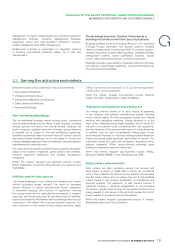APC 2012 Annual Report Download - page 30
Download and view the complete annual report
Please find page 30 of the 2012 APC annual report below. You can navigate through the pages in the report by either clicking on the pages listed below, or by using the keyword search tool below to find specific information within the annual report.
2012 REGISTRATION DOCUMENT SCHNEIDER ELECTRIC28
OVERVIEW OF THEGROUP’S STRATEGY, MARKETS AND BUSINESSES
1RESEARCH&DEVELOPMENT
4.3 Achieving the platform strategy
The platform strategy initiated late 2011 defi nes, within targeted
development areas, the core technologies that will be developed
jointly (between all businesses) and the components that will remain
under the responsibility of a single business. This approach seeks,
in addition to effi ciency gains, to increase Schneider Electric’s
capacity to innovate :
•better alignment of R&D resources and development programs;
•faster integration of acquisitions, as demonstrated by
StruxureWare;
•increased ease of integrating third-party products into Schneider
Electric solutions due to the defi nition of interoperability standards.
In 2012, our Innovation and Technology Board proposed the
extension of the platform strategy to six major areas, which represent
80% of the technologies that are common to all businesses.
In addition to traditional areas such as embedded control or
supervision control (SCADA), the platform strategy includes
emerging domains such as “operational intelligence”. A critical
link between business systems and control systems, operational
intelligence combines data from these two levels to optimize the
operational performance of the Company.
4.4 Large scale collaborative projects
In p arallel to major internal programs like EcoStruxure and the
platform strategy, we are also involved in numerous collaborative
projects with third parties.
Collaborative energy efficiency program
The HOMES program was completed at the end of2012. HOMES
is the largest European program addressing energy effi ciency of
buildings. Schneider Electric led the program for four years, with a
budget of EUR88million bringing together 13academic, technology
and usage specialist partners. The integration of the developed
technology and prototypes began this year and will continue
in2013. The program has contributed a large number of results:
•standards and regulations: changes to EN15232 on technical
building systems, labels, new construction regulations or
administrative regulations for operational site;
•lobbying the directorate of the European Union and national
governments to push SAEI (Site Actual Energy Index), the
sites instrumentation plan and prioritization of energy effi ciency
investments;
• energy savings, return on investment, job creation and
forecasting;
• training for engineering, technic al , or primary schools with the
“mini homes” model.
The program also opened new fi elds of investigation, which our
teams are now preparing and which will enable new collaborative
programs and partnerships.
Projects around Smart Cities
In2011, three new Smart Grid projects were launched. In 2012, the
theme was Smart Cities:
AMBASSADOR: European project led by Schneider Electric, with
15 partners over a period of four years. This project proposes
a solution to defi ne optimal energy management strategies
in eco-districts. The project will be based on three test sites:
Chambery, Athens and London.
ODYSSEUS: European project led by Schneider Electric (Telvent),
with nine partners over a period of three years. This project aims
to develop a software system to support the overall management
of the supply, demand and storage of energy in urban areas. The
software will be based on the development of a dynamic energy
profi le card attached to each node of the network. Neighborhoods
in Rome and Manchester will illustrate the results of the project.
Co-innovation with respect to electric vehicles
I n terms of charging terminals, the important lines of research for us
and our partners are:
•ease of charging, which is one of the key factors in the public’s
acceptance of electric vehicles;
•induction charging, a wireless solution, will make charging much
easier for users. Studies and initial experiments carried out have
resulted in an innovative prototype, which will be tested in a
Renault vehicle in the months to come;
•development of standardized offers thanks to two collaborative
projects, one French (CINELLI) and one European (WIC2IT).
Contribution to communication standards
We are one of the most active members of the ZigBee alliance and
are particularly involved in the proposal of a protocol called Green
Power, a radio communication standard with extremely low energy
consumption that can be used in self-powered devices (e.g., by
solar power).
In August2012, the ZigBee alliance formally accepted the Green
Power standard, and it is currently being integrated into the Home
Automation and Building Automation applications. This will ensure
broad adoption of this protocol and the interoperability of the
network of diffused sensors.
























